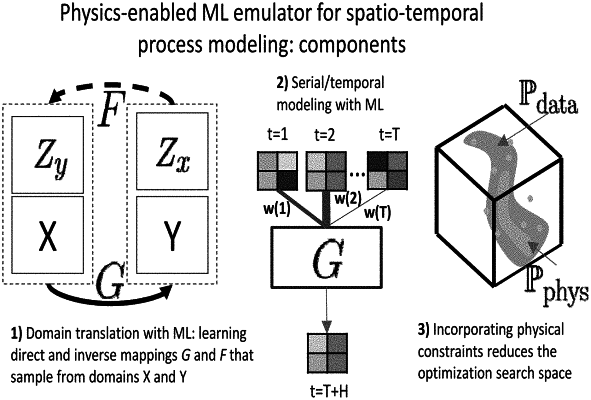| CPC G06F 30/20 (2020.01) [G06N 20/00 (2019.01); G06F 2111/10 (2020.01)] | 19 Claims |

|
1. A method for generating simulations of physical variables of a physical system, comprising:
obtaining observational data, wherein the observational data includes at least one source of physical data, comprising one or more sensors sensing the physical data;
obtaining, by one or more computing devices or storage devices that are connected through one or more networks, numeric simulation data;
fusing, by one or more computing devices, the observation data and the numeric simulation data, comprising:
preprocessing the observational data and the numeric simulation data to remove inconsistencies of the observational data and the numeric simulation data;
processing the preprocessed observational data and the numeric simulation data to extract interpretable structures and patterns within that data using ground truth and labeled information to create domain interpretable data;
normalizing the preprocessed observation data, the numeric simulation data, and the domain interpretable data layers;
increasing a resolution of a gridding of the normalized preprocessed observation data, numeric simulation data, and domain interpretable data layers;
training a spatial-temporal emulator model for a physical numerical model using the normalized preprocessed observation data, the numeric simulation data, and the domain interpretable data;
incorporating prior knowledge of the physical system into the spatial-temporal emulator model;
the method further comprising estimating, by one or more computing devices, one or more physical parameters of the physical system based on the trained spatial-temporal emulator model;
compressing the trained spatial-temporal emulator model, comprising:
1) generating candidate mutations of an architecture of the trained spatial-temporal emulator model to reduce a number of parameters or connections of the parameters;
2) evaluating a performance of each of the candidate mutations of the architecture on validation data using metrics;
3) retaining a subset of candidate mutations exhibiting best performance on the metrics; and
4) iterating steps 1-3 until convergence to a desired reduction in size of the trained spatial-temporal emulator model, yielding a compressed trained spatial-temporal model; and
the method further comprising utilizing, by one or more computing devices, the estimated one or more physical parameters for at least one of a plurality of applications.
|